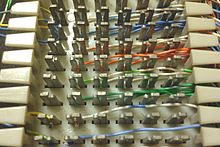Punch-down block
A punch-down block (also punchdown block, punch block, punchblock, quick-connect block and other variations) is a type of electrical connection often used in telephony. It is named because the solid copper wires are "punched down" into short open-ended slots which are a type of insulation-displacement connector. These slots, usually cut crosswise (not lengthwise) across an insulating plastic bar, contain two sharp metal blades which cut through the wire's insulation as it is punched down. These blades hold the wire in position and make the electrical contact with the wire as well.
Overview
A tool called a punch down tool is used to push the wire down firmly and properly into the slot. Some will automatically cut any excess wire off.[1] The exact size and shape of the tool blade varies by manufacturer, which can cause problems for those working on existing installations, especially when there is a poorly documented mix of different brands.
Punch-down blocks are a very quick and easy way to connect wiring, as there is no stripping of insulation and no screws to loosen and tighten. Punch-down blocks are often used as patch panels, or as breakout boxes for PBX or other similar multi-line telephone systems with 50-pin RJ21 (Amphenol) connectors.[2] They are sometimes used in other audio applications, such as in reconfigurable patch panels.
Often a separate tool known as a spudger is used to remove small stray pieces of cut off wiring stuck within punch-down blocks.
Reliable connections
It is possible to insert wiring without the proper tool, but this requires great care to avoid damaging the connectors. For example, pushing a screwdriver down the middle of the block is a bad practice as it forces the two blades of the terminal post apart, leading to bad contacts. It is also possible to punch down multiple wires on top of each other in a single post of a punch-down block, but this practice is discouraged because of reliability concerns. If these multiple wires are of different thicknesses (wire gauges), it is even more likely that the thinner wire will develop contact problems. Similarly, stranded wire can be used on punch-down blocks, but they are designed for solid wire connections.
이와 같은 한계적 관행은 대규모 또는 미션 크리티컬 설비에서 강력하게 금지된다. 왜냐하면 그것들은 매우 골치 아픈 간헐적 연결뿐만 아니라 더 명백한 완전 불량 연결까지 초래할 수 있기 때문이다. 펀치다운 블록의 접촉 블레이드가 잘못된 관행에 의해 "분리"되면, 신뢰할 수 있는 연결을 복원하기 위해 블록 전체를 교체해야 하는 경우가 많다.
또한 펀치다운 블록은 더 많은 수의 더 빠른 데이터 신호를 처리하기 위해 사용되어 임피던스와 크로스스토크를 제어하기 위한 더 많은 주의와 적절한 절차가 필요하다.[3]
예
- 66 블록(또는 "M 블록")은 구형 아날로그 전화 시스템에 사용된다.[4]
- 110블록은 주거용 전화와 Cat 5 와이어 시스템에 자주 사용되며 66블록을 대체한다.[4]
- 크론 블록은 독점적인 유럽 대안이다.
- BIX 블록은 Nortel Networks가 원래 개발한 독점 블록이다.
참조
- ^ 2007년 4월 30일에 마지막으로 액세스한 통화 녹음 블로그
- ^ Versadial, 통화 기록 약관/정의, 2015년 6월 8일에 마지막으로 액세스
- ^ McLaughlin, Patrick (May 1, 1998). "Blocks and patch panels gear up for gigabit traffic". Cabling Installation & Maintenance. Retrieved 2011-03-27.
- ^ a b Michal, Keith A. "Wiring Block Techniques and Tips". Retrieved 2011-03-27.
외부 링크
![]() Wikimedia Commons의 Punch down 블록과 관련된 미디어
Wikimedia Commons의 Punch down 블록과 관련된 미디어







